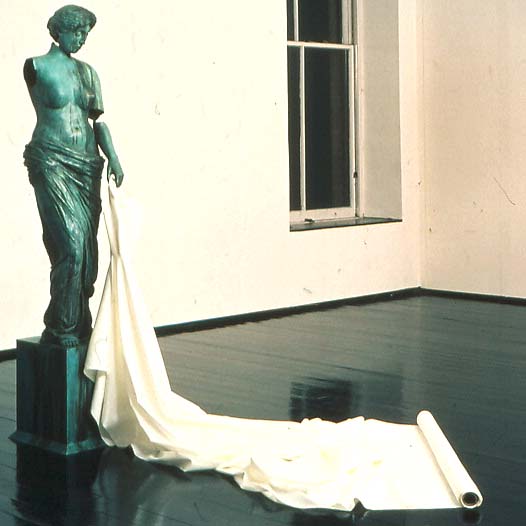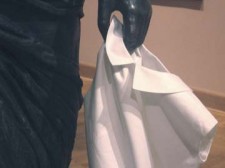Judith Shea Research – Various Documents

Judith Shea
American, 1948-
Mid-Life Venus, 1991
bronze with fabric
84 x 17 1/2 x 17 1/2 in. (without fabric)
SBMA, Museum purchase with funds provided by Leatrice and Eli Luria and the Luria Foundation, Wendy and Elliot Friedman, and the 20th-Century Acquisition Fund
1999.32

Undated photo of Shea
RESEARCH PAPER
The Artist:
Born in Philadelphia in 1948, Judith Shea spent her early childhood in middle-class suburbia where her parochial school education and constant exposure to religious statuary - especially the sumptuous draping of painted wood fabric over saintly bodies - would prove to be a powerful influence on her later work. "The first sculptures I ever saw were not in museums but figures in churches. I was fascinated by those statues and tried to figure out what they were saying and doing. All that is in my work." 1 Her childhood interest in clothing led her to the Parson's School of Design in New York where she earned an Associate of Arts degree in 1969. While working professionally as a designer, she became frustrated with the restrictions and lack of hands-on involvement. Returning to Parson's, she received her B.F.A. in 1975 and turned her attention to making art.
Against the backdrop of the Women's Movement, the 1970s was a time when painting, as a medium, was under attack : certain feminists had raised political questions about painting based on the lingering machismo with which the medium was associated since Abstract Expressionist times. It was a time when it was of some importance for women artists to find ways of making an art that spoke to women as women. 2 And Shea did, by exploring clothing as sculpture choosing a hollow dress as her trademark. Almost nothing speaks to differences in gender the way articles of clothing do; in choosing the dress, Shea clearly reflects political issues central to feminist concerns. But while art critics believe Shea's portrayals of women - saintly, godly or otherwise - in many ways suggest self-portraits, she is also very much a woman of her time grappling with personal issues that resonate with all women.
As a figurative artist, Shea carved out her unique niche in significant sculpture using clothing both as sculptural object and as surrogate for the human form. Her first widely exhibited works were simple, flat pieces of cloth used as abstract forms and later as surrogates for the human presence itself, using hollow dresses (or their vestiges) for women ( Inaugural Ball ) and voluminous overcoats for men ( The Other Monument ). Maintaining the elegant simplicity of the Minimalist style, Shea ventured beyond vestiges to garments and by the end of the decade, finally began to focus more directly on the human figure.
In 1981, while teaching a class in Medieval European Armor at the Metropolitan Museum of Art, Shea began casting fabric in iron and bronze. In 1982, she produced Crusader, one of her first cast pieces referencing the human form with clothing. Shea made a sensation in the world of sculpture with empty bronze or iron casts of articles of clothing swelled with the bodies of invisible wearers. They were haunting, ghostly, and true to the prevailing aesthetic of Minimalism.
A trip to Greece in 1983 proved a powerful influence, arousing the artist's interest in ancient cultures. But it was a trip to Rome in 1994 on a fellowship that gave her the opportunity to really immerse herself in the study of classical Roman sculpture. She was struck by the work of both Bernini and Michelangelo, specifically, the passion expressed in their art. 3 Influenced by the masters of the High Renaissance, Shea's new pieces became more fully figurative and evocative of classical sculpture; her bronze and iron pieces were draped and shaped like Roman statuary. In the mid-80s, merging classicism with abstraction, Shea began juxtaposing figures with clothing forms and then pairing figures to give her work added psychological complexity as seen in her piece, Between Thought and Feeling (1988). She also began imbuing her faces with emotional expression.
But western classical art was not the only major influence on Shea. From an early job at the United Nations folk-art shop to a sojourn to Oaxaca, she strove to integrate her love of classical sculpture with a focus on contemporary life. Mexican folk art, with its exaggerated human forms and strong craft sensibility, offered both abstraction and representation. Churches full of saint figures, all of them dressed in handmade clothes - some even with real hair - was a magical synthesis of the Catholic iconography of Shea's youth with her love of classical Greek form, and a lifelong obsession with clothing.
Mid-Life Venus, 1991
Mid-Life Venus , executed in 1991, refers to the Hellenistic sculpture Venus de Milo, half-draped from hips to ankles in the manner of classical Greek sculpture and elevated on a bronze base to a height of 84 inches. In contrast to her famous predecessor, Mid-Life Venus is portrayed as being older; the breasts are heavier, her expression more pensive. Her face is also cracked and slightly caved in, with a tear rolling down her cheek. Missing her right arm and most of her neck, Venus holds in her left hand (extending from an arm Shea added) the collar of a pristine, white, sleeveless girl's dress made of real cloth, which falls to the floor, billowing yard after yard (8-10') only to end in the rolled bolt of material from which it sprang.
At first glance, the sculpture is shocking in its pairing of bronze and cloth. But duality is the essence and richness of Mid-Life Venus , inviting the viewer to think about the title and experience this sculpture and the range of emotions it evokes. While the body of Venus is maternal, broken, and static with a carved fabric draping her body that is reminiscent of classical statuary, the cloth dress is pristine, youthful. The strong vertical line of Venus' body is in direct contrast with the fabric cascading across the floor, a horizontal dimension adding tension to the larger-than-life tableau. The greenish glaze of the bronze suggests the ravages of time as the aging goddess holds on to a dress, the bodice reminiscent of a girl's gown, white with youthful promise and a life yet to be lived. Light reflecting off the soft white material heightens the distinction between it and the subdued cast of her time-worn patina.
Mid-Life Venus is quintessential Judith Shea complete with signature image - the hollow dress, a vessel into which the viewer may project personal feelings. What is this dress and why is Venus crying as she beholds the garment? It is the nature of the dress and the sadness it evokes in her that invites the viewer to search for meaning and significance. According to the artist, "Venus de Milo is (was) a feminine ideal, the goddess of love and beauty--here ravaged by time. It's a metaphor of age, both the artwork and the person. Regarding aging: it's the unknown that does damage." 4
The choice of a pure white gown was also deliberate. The bodice suggests the form of a girl or young woman, a small, slender, youthful figure. According to Shea, the dress represents the opposite of aging Venus. "It represents a pubescent female. The bust darts are very shallow; it is the dress of a young girl, a girl on the verge of becoming a woman. It's about purity, innocence. I chose the material very carefully. The bolt of cloth is cotton satin: pure but with a little bit of shine - the purity of childhood, but with the promise of womanhood, the undamaged female, 'right out of the chute.'
Further, the dress is still attached to the bolt of fabric; she hasn't even cut the cord yet (referring to the left hand of Venus holding clutching the dress)." 5
Clearly, Shea's youthful dress, as held by the tearful, aging ambassador of sexual love in all her matronly physicality, represents a tangible memory of all that the dress itself stands for, including the body of she who wore it. The sense of loss expressed by aging Venus is clear and powerful.
The tear on Venus' cheek as she gazes down at the dress slipping from her hand evokes a certain sadness and poignancy in the viewer. The tear is also what adds an element of dejection to our Venus; the gown belonged to a moment when the wearer was young, innocent, poised on the precipice of life. The viewer can imagine the classical Venus, lithe with beauty, proportion, and allure. She looked like that then, but she does not look like that now. There is a palpable melancholy in our aging Venus - the melancholy that comes not only with bodily aging, but also the loss of purity, innocence.
When she created Mid-Life Venus in 1991, the artist was 43 years old, a woman at the crossroads. And Shea indeed confirms what art critics have suggested - that the piece is autobiographical. "It's about me at a certain age, as an artist and a woman. Do you "revamp" and try to stay young? There are issues of youth and beauty. Do you try to change, or allow the character to grow?" 6 Shea adds that her particular choice of materials is referencing her life course as well, stating, "I was doing bronzes in the mid-1980s. But my earlier work was out of cloth. So it is about viewing ourselves--my own history, my genesis: from cloth to bronze."
Now in her late 50s, Shea has moved away from classical sculpture and historical figures to highly descriptive portraiture (busts in wood, bronze) of well-known saints (Mary Magdalene, St. Francis, Joan of Arc) portrayed as anonymous, everyday people with painted faces and real hair. Yet her themes of empathy and abstraction remain. "For me, what I'm doing now is a continuation of what I've always tried to do--to make sculptures, whether they are extremely formal or obsessively descriptive, that will express human states."
In summary, Midlife Venus is a perfect expression of the major influences throughout Judith Shea's career. Her love of ancient Greek and Roman sculpture - the beauty and proportion as well as the passion she found in Bernini and Michelangelo - as well as the Catholic saints and martyred Christ's of her youth reborn in Mexican folk art, all converge to make her work human, relevant. Shea's career evolution from Abstract Minimalist to figurative sculptor and finally to descriptive portrait artist continues to reflect ongoing themes of empathy and abstraction, ancient and historical, intimate and universal.
Based in New York, Judith Shea's sculpture has been exhibited in galleries and museums worldwide since the mid-1970s.
Prepared for the SBMA Docent Council by Lori Mohr, 2007.
Footnotes
• Shea, Judith. Quoted in Martin Friedman, "Judith Shea: Seven Characters on the Verge of a Revelation," Sculpture Magazine (March 2005, Vol 24 No.2).
2. Adams, Brooke. "Shea's Anti-Monuments," Art in America . April 1993.
• Berggruen, J. Gallery. "Judith Shea: Statues." Past and Future Exhibitions, (October/November 2004).
• Interview with Judith Shea by Dr. Jill Finsten, April 25, 2007.
• Ibid
• Ibid
Bibliography
Danto, Arthur. "The Poetry of Meaning and Loss: The Glass Dresses of Karen LaMonte." Essay from the exhibition catalogue for Absence Adorned , University of Washington Press.
Hollander, Anne. Seeing Through Clothes Berkeley: University of California Press, 1993

Close up of the detailing
SBMA CURATORIAL LABELS
Judith Shea began her career as a student of fashion in New York in the early 1970s before shifting her attention to sculpture. She soon became involved in the New York-based movement called New Image, which sought to reassert the value of figuration in response to the then dominant Minimalist and Conceptual Art.
Shea’s early work consisted of cast clothing that referred to a body that was hauntingly absent. More recent works, like Mid-Life Venus, combine actual clothing with figurative sculptures that reference historical artworks. In this work, Venus, the Roman goddess of love, is a direct citation of the famous ancient statue, Venus de Milo. She is missing an arm and evidences the ravages of time, but unlike the classical work, this Venus is a bit older, as its title humorously suggests. She clutches a white dress, which cascades into fabric, terminating in the bolt from which the dress was cut.
Through the use of clothing, Shea addresses its powerful role in shaping social meaning and in defining personal identity and social class. She extends these feminist explorations to include an acknowledgement of the power of the “male gaze” to possess a female body – regardless of what clothes it. In contrasting the contemporary clothing with a quotation from classical art, Shea also encourages dialogue about reality and socially constructed notions of ideal beauty.
- SBMA Label, n.d.
